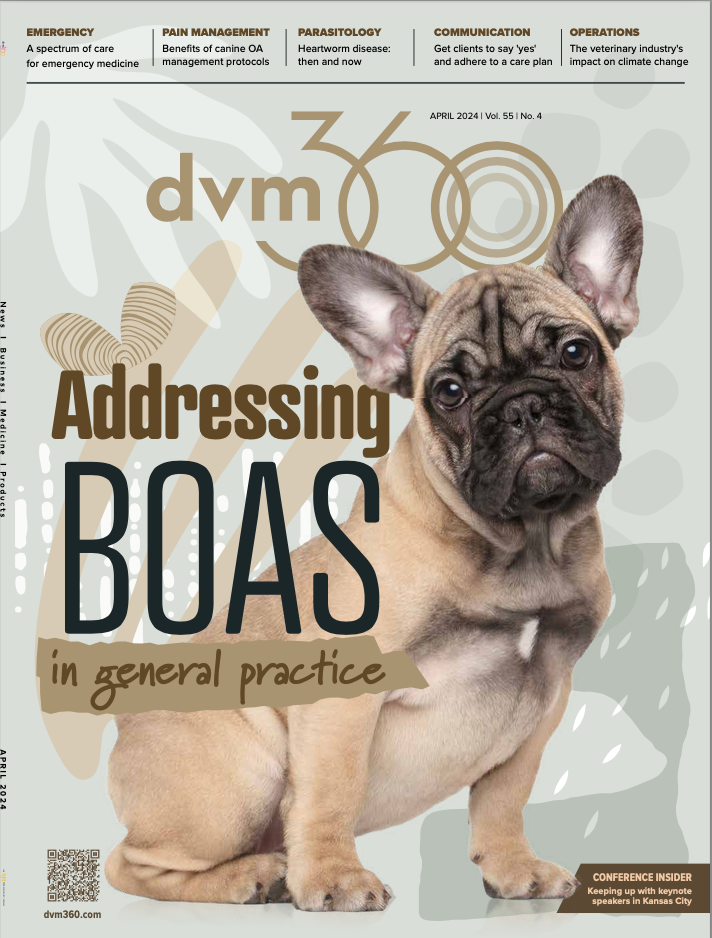How to get clients to say “Yes” and adhere to recommendations
Uncovering the root causes can help resolve clients’ concerns
Prostock-studio / stock.adobe.com

The stories are all too common. Buffy should have blood work, Calvin should be on long-term medications, Spike needs a progress exam...and their owners are dragging their feet or outright declining. The team is frustrated with the lack of adherence to their recommendation and is on the edge of a downward spiral, from blaming their colleagues to vilifying the clients. Can you right this ship? Can you identify what is misaligned and get patient care back on track? You can—not by using strong-arm tactics on clients or team members, but by understanding the root causes of nonadherence and building client relationships and trust.
Root causes of nonadherence
Before laying the blame at anyone’s feet, take a moment to evaluate the communication between the team member and the client. This does not mean accusing anyone of failure. No, this evaluation should be a systematic process of sequential steps to determine where the barriers to adherence occur. These steps help the veterinary team understand where to begin the conversation with the client when there is a barrier.
Step 1: Is my client aware of the problem?
If not, start your communication here and do not assume the client understands the issue. Consider providing educational materials (via text, email, or printed copies) on the disease process while they wait for diagnostics or the next steps.
Step 2: Is my client involved in the problem?
Does your client seem committed to learning how to change their pet’s lifestyle? Are they concerned about cost? Education can help them see that treatment can involve small steps, but it takes their involvement.
Step 3: Does my client want to do something about the problem?
Turn the client from a passive information processor to an information seeker (ie, they need more information or clarification).
Step 4: Is my client confident that they can do something to solve the problem?
Does the client believe they have the ability to complete the task? Brainstorm solutions, show the client success stories, and encourage them.
Step 5: Does my client have the tools they need to solve the problem?
Give them basic information and point them to some educational resources to learn more about the disease, diagnostics, and treatment. Acknowledge the client’s right to defer to a specialist or other resources.
Step 6: Are there financial constraints, cultural and/or language barriers
that keep them from committing?
It is essential to remain nonjudgmental and offer clients solutions that suit their needs but still honor our oath to provide patient care. Open communication helps to manage expectations when there are limitations to care.
Behavior change (eg, client adherence) can be achieved once all the steps are actively addressed. This change does not always happen overnight. It may require professional development of veterinary teams, updating medical protocols, building relationships with clients, and understanding barriers our veterinary clients face when making decisions about their pet’s health care.
The sequential steps help the team present information about the pet’s medical condition. It is easy for the team to skip steps because they are already knowledgeable about medical conditions. However, the client needs information. Many team members start a conversation with “Calvin has _________ and needs to be on this medication every day. We will see how he is doing in 6 months.” The veterinary team knows the condition is manageable with daily medication, so it should be an easy solution—case solved. But the client balks. What is the problem?
Check by using these sequential steps:
EXAMPLE: Calvin has osteoarthritis (OA) and needs daily medication.
Step 1: Is my client aware of the problem? Maybe the pet was in for an annual wellness exam, so the diagnosis surprised the client. Don’t assume the client knows about the problem.
Step 2: Is my client involved in the problem? If the pet is not visibly ill, the client may not consider this a serious concern and is willing to wait and see. This is commonly seen in cases of OA. The client doesn’t feel that the pet is in pain because the pet is not vocalizing or limping every day. This is an opportunity to educate clients and ask specific questions about their pet’s activity levels.
Step 3: Does my client want to do something about the problem? Is the client responding to your call to action or merely taking in what you are saying and planning to get back to you? Maybe the client is confused and needs time to assess and clarify the information you are giving them. Veterinary team professionals must ask the client: “Are there additional questions or concerns you have with the treatment?” This is paramount with chronic disease processes.
Step 4: Does the client lack confidence or self-efficacy? The client may not be able to administer the medication twice a day. What if the client hates wrestling the pet to administer the medication or is frequently out of town and relies on others to care for the pet? If oral medication is not an option, then compounded medicines in other forms may solve the problem. Some veterinary hospitals offer technician appointments for outpatient treatments as a last resort. Also, we must understand that not every patient is the right candidate for certain types of care. These conversations allow clients to know their options, which can improve adherence.
Step 5: Does the client have the required tools and skills? This could be the skill of administering the medication, knowledge about the medical condition, and a commitment to attend follow-up visits. Don’t let Dr Google give the tools; have the team regularly communicate with the client and have the necessary resources available.
Step 6: Are there any barriers to consider with the standard of care? Are there financial concerns with continued follow-up? Some clients may have brought in their pet but step 4 is the barrier. Maybe step 5 is the barrier because the client is interested in holistic treatments, which is not something you offer. Are there cultural differences in why a client won’t pursue a treatment option? Are there language barriers? All of these must be addressed.
Health literacy and nonadherence
Another potential barrier is health literacy, the degree to which an individual has the capacity to obtain, communicate, process, and understand health information and services in order to make appropriate health decisions.1 Health literacy is not the same as illiteracy, although they are often related. People who read well and are comfortable using numbers can experience health literacy issues.
How often do you see clients unfamiliar with medical terms or how their pet’s body works? Can all your clients evaluate the risks and benefits affecting their pet’s health? When you deliver a serious pet diagnosis, do any of your clients become scared or confused? How great is client adherence when the pet’s health condition requires complicated at-home care? The National Assessment of Adult Literacy reported in 2017 that “just 12% of Americans possess competent health literacy skills.”2 Health literacy is a priority issue in human medicine, but it extends beyond human health care into veterinary health care.
Low health literacy skills can affect pet health. Consider the following prescription labels: “Give 2 tablets twice daily for 14 days” or “Give 1 tablet today, 2 tablets tomorrow, then 3 tablets daily until finished.” These sound like simple labels for any medication dispensed to treat a pet’s condition. However, in a study of human patients receiving a group of labels as examples for their medication, 46% did not understand the instructions and 38% with adequate literacy skills misunderstood at least 1 label.”3 Think about your clients and what they could be missing on their pet’s prescription bottles, which makes them appear nonadherent to your recommendations.
Low health literacy skills affect more than understanding prescription labels. According to the Agency for Healthcare Research and Quality, and the CDC, low health literacy also may appear as follows:2-4
- Frequently missed appointments
- Incomplete registration forms
- Nonadherence to medication
- Inability to name medications and explain their purpose or dosing
- Identifying pills by looking at them (color, size, shape), not by reading the label
- Inability to give coherent, sequential history
- Fewer questions asked
- Lack of follow-through on tests or referrals
- Not receiving treatment or receiving treatment too late
- Not giving medication correctly or making other dangerous mistakes
- Poor treatment outcomes
- Treatment and other services needed to a greater extent than those with good health literacy
- Lower client satisfaction rates
Are any of your clients represented by any of these red flags? Could some of your clients be nonadherent because of low health literacy skills?
The FDA has an animal health literacy website with a section called “Medications for Your Pet...Questions for Your Vet.”5 Spend a team meeting reviewing the questions and guide your team on ways to overcome any barriers to medication adherence.
Nonadherence by clients can be multifactorial, but with a strategic approach and a committed team, you can identify the root of it and implement solutions to ensure the best outcome. It is critical to get the support and expertise of your team, as each will play a role in improving client adherence. Involve them and create goals for your hospital so that you can have sustainable success.
Louise Dunn is the owner of Snowgoose Veterinary Management Consulting in Winston-Salem, North Carolina, and a former practice owner. She has taught practice management workshops at 10 veterinary schools and publishes and speaks nationally. She is a founding member of VetPartners and a member of other professional organizations.
References
- What is health literacy? Centers for Disease Control and Prevention. July 11, 2023. Accessed March 6, 2024. https://www.cdc.gov/healthliteracy/learn/index.html
- Helping patients improve their health literacy: effective strategies for nurses and nurse managers. Bradley University. May 1, 2017. Accessed March 6, 2024. https://onlinedegrees.bradley.edu/resources/articles/helping-patients-improve-their-health-literacy-effective-strategies-for-nurses-and-nurse-managers/
- Davis, T. Health literacy: hidden barriers and practical strategies. Agency for Healthcare Research and Quality. US Department of Health and Human Services. https://slideplayer.com/slide/4900269/
- Watts SA, Stevenson C, Adams M. Improving health literacy in patients with diabetes. Nursing. 2017;47(1):24-31. doi:10.1097/01.NURSE.0000510739.60928.a9
- Medications for your pet…questions to ask the vet. FDA. February 20, 2024. Accessed March 12, 2024. https://www.fda.gov/animal-veterinary/animal-health-literacy/medications-your-pet-questions-your-vet
